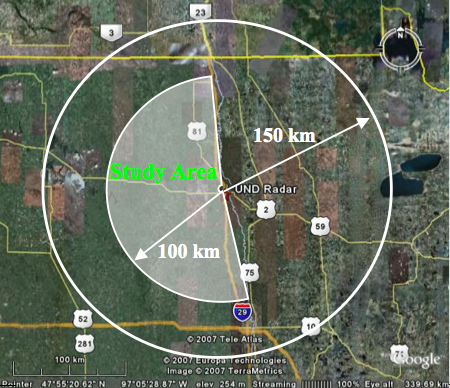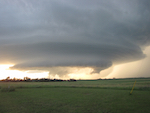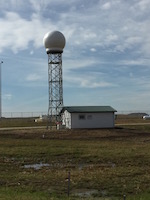The ARB has been involved in weather modification research since its creation by the legislature in 1975. Weather modification research in North Dakota, however, goes back to research pilot programs that were conducted over parts of western North Dakota during the 1960s. Many advancements in cloud seeding technology, especially in the area of hail suppression have come as a direct result of research and operations in North Dakota.
Polarimetric Cloud Analysis and Seeding Test (POLCAST)
Having already conducted numerous research programs studying the benefits of glaciogenic cloud seeding (enhancing the ice process in clouds), the North Dakota Atmospheric Resource Board brought together the University of North Dakota (UND), Weather Modification Inc., and Ice Crystal Engineering in 2006 for a new kind of cloud seeding research. The Polarimetric Cloud Analysis and Seeding Test, or POLCAST, operated initially in 2006 as an exploratory field study to determine whether liquid water content was increased in clouds seeded with hygroscopic (salt) particles. Utilizing data from UND’s dual-polarimetric radar, initial indications found increases in cloud liquid water content in seven out of eight seeded cases.
The results from the exploratory study prompted a more comprehensive experiment. POLCAST was re-scoped as a randomized research program over eastern North Dakota with short field campaigns in 2008, 2010, and 2012. During this multi-year field experiment, a seeding aircraft was dispatched from Fargo when atmospheric conditions were favorable for the development of convective storms within 100 kilometers of Grand Forks (see Study Area map). The aircraft remained within this close range in order to maintain the quality of radar data being collected by UND's dual polarization radar. The randomization process consisted of the radar operator drawing a sealed envelope with a "seed" or "no seed" card inside. Once a suitable cloud was located by the aircraft, the envelope was opened to reveal the decision. Neither the pilot nor radar operator knew of the decision in advance, thus eliminating selection bias. After a developing cloud was either seeded or not seeded by the aircraft, radar data continued to be collected until the cloud dissipated so that a full lifecycle was observed. A total of 33 cases (16 “no-seed” and 17 “seed”) were put through a variety of statistical analyses. Some of the more important conclusions from POLCAST field research were:
- Seeded clouds yielded 56% more rainfall than non-seeded clouds.
- Seeded clouds had longer lifetimes than non-seeded clouds (41% of seeded clouds lasted 60+ minutes, compared to 25% of non-seeded clouds).
- The rain rate in seeded clouds was higher than non-seeded clouds.
- The average raindrop size and cloud liquid water content was higher in seeded clouds.
Though all of the results indicated positive effects of hygroscopic seeding, none met accepted statistical confidence levels due to the relatively small number of cases.
In the future, the possibility exists that the North Dakota Cloud Modification Project (NDCMP) could employ hygroscopic seeding operationally for hail suppression and rain enhancement. This would depend on the natural concentration and size of particles already present in the atmosphere on a given day during the seeding program.
Weather Damage Modification Program (WDMP) 2002-2005
ND Tracer Experiment 1993
A multi-agency research program designed to examine thunderstorm evolution with emphasis on tracer transport and precipitation evolution.
ND Thunderstorm Project 1989
A multi-agency research program designed to examine a number of facets of thunderstorm characteristics and evolution.
NOAA Atmospheric Modification Program
The National Oceanic and Atmospheric Administration sponsored a cooperative state/federal research program dealing with convective cloud processes and their potential modification. The program was active from 1980-1994.
Research Bibliography
A comprehensive list of all of the technical papers completed in the scope of ARB research activities.





